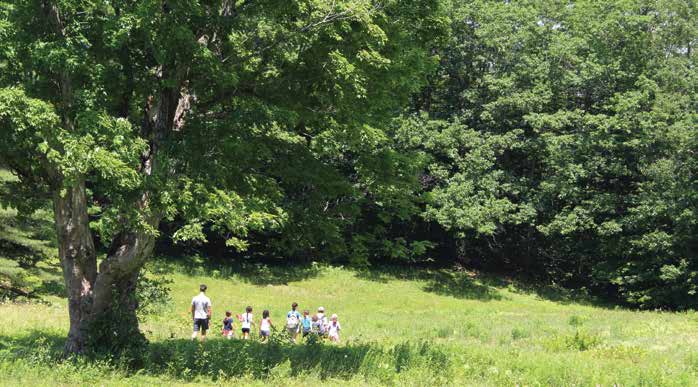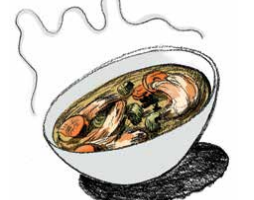
What the Periphery Can Teach the Center
It is 6:45 a.m. on a Sunday morning in April, and I am sitting in a coffee shop in Brookline, MA, with two young women. We’re staking out this very spot, across the street from the closest kosher supermarket to the town we live in, 185 miles away. The supermarket doors are due to open at 7A.M., and we’re sipping much-appreciated coffee as we watch a line slowly accrue at the door. I feel the 13 days until Passover perching demon-like on my shoulder.
We are here for Pesach shopping, naturally, and my 19-year-old ally is doing this sort of mad run for the first time. She’s a fellow for the Center for Small Town Jewish Life, where I and my other young colleague work, and president of the local Hillel. The three of us had aggressively workshopped the Hillel Passover shopping list on our ride through interminable Boston traffic. I myself have four lists in my pocket, covering what feels like the needs of every Jew for several zip codes in any direction. The teenager eyes the growing queue with frank disbelief. “I kind of can’t believe I’m doing this,” she murmurs into her coffee. I grin. “Welcome to Maine Jewish womanhood!”
I want to be clear: it is not like I did not wait in crazy-long lines at kosher supermarkets back when I lived in Brooklyn, not like I didn’t schlep groceries for friends or spend crazy time and effort on holiday preparations. But until I moved to small-town Maine, a state that clocks in with a mere 1.3 million people,there was never any undercurrent of desperation to these acts; they were never freighted with the certain knowledge that, if we didn’t drag ourselves down to do a town’s worth of shopping, there might not be food for Passover.
Expand that thought outward, to the half-dozen sleeping teens we’d brought with us to Boston for a weekend Shabbaton from some of the furthest fringes of rural Maine communities, and it emphasizes the heavy weight of responsibility we all feel: but for the work of every parent, rabbi, Hebrew school teacher, there might not be a Jewish future in Maine at all. But in our synagogues, in our homes, in the gorgeous woods where we take our Shabbat walks, we all will that Jewish life into being, and it is not a dream.
I was teaching an informal session on Jewish feminism to college students recently, and they asked me to define feminism. I prefer a classic turn of phrase, I explained, so I go with “the radical idea that women are people.” To invest in such an idea makes as much sense as it ever did for me, and knots just as surely together with the concept of k’avod habri’ot, the equally classic Jewish value of respecting the dignity of living things. It means something different, though, on the periphery where we live (periphery in nearly every sense, from geographic to economic). The firm emphasis we put on dignity and deservingness—that unspoken you matter, too that infuses the work I do—is the same Jewish and feminist ethic that saved me in my own youth from the undertow of low self-regard. But it’s a lifeline of a different sort here in the wilds.
I have been in Maine for eight years, working for local Jewish communities until a couple of years ago, when my work was largely gathered together under the umbrella of the brand-new Center for Small Town Jewish Life. The CSTJL was founded by a dynamic young rabbi, Rachel Isaacs. (Full disclosure: she is my wife, and it was my marriage to her that brought me to Maine in the first place.)
Recruiting a very small cadre of Jewish professionals, we have built a team and an organization to serve Maine’s Jewish communities. Depending on how you count, there are something in the neighborhood of eleven synagogues in Maine—so around one for every three-and-a-half thousand square miles. There are about as many people in our largest city as in my old neighborhood in New York.
This work is difficult, logistically challenging, never-ending, and deeply rewarding. It is also animated, implicitly and explicitly, by profoundly feminist ethics. Some of our efforts are smaller, and perhaps more obvious—children are always welcomed at our events, and my younger daughter nursed her way through so many meetings I thought she was going to start taking dictation.
We bake into our other activities that feminist awareness of the needs around us. For example, when we intentionally undercharge for CSTJL programming, it’s not only that we acknowledge that ours is an economically diverse community, with plenty of people living below the poverty line. It’s also that we understand how soul-crushing it can be to apply for scholarships over and over again, how many people would rather stay away than go through the debasing experience of feeling like they’re a drain on the community’s resources.
Overcoming the communal low self-esteem of so many parts of the Maine Jewish community is an ongoing project. In part, we achieve it by bringing to bear the resources of our partners (like Colby College, where we’re housed) and contacts with diverse Jewish social networks to bring the lights of Jewish civilization to our quiet towns.
We try to figure out which underserved populations we can reasonably serve. So, in a state with no meaningful national Jewish youth group presence, we launched our own, charging five dollars per event.
In a climate where you assume that synagogue events are cancelled between December and March, we launched winter online learning for adults with an organization called Project Zug; zug is Hebrew for a pair. We began a rabbinical student fellowship to expose the next generation of Jewish leaders to the particular challenges and exquisite pleasures of small towns. We run about a doze tracks of programming every year. And we are continually working to find new small communities out in the world with which to share ideas.
This larger work is about building something—or rebuilding, as in the case of our now six-year-old Maine Conference for Jewish Life, modeled on the Conference for Judaism in Rural New England of the ‘70s and ‘80s. But making Jewish life from the ground up (or the chicken up, as is sometimes the case) is a way of life here, as I imagine it is in a variety of rural and small-town locales Jewish life was more vibrant here back before the interstate, when mills and a glut of Jewish tailors turned my town into a men’s fashion powerhouse in the region. But even in the old days, they still brought kosher meat in from the butchers in Portland, an hour south, by Greyhound bus.
I think of that during my own 80-mile drives for kosher meat. I thought about it the first time someone asked me—decidedly a non-rabbi—to serve on a beit din, a court of Jewish law that decides on conversion and other subjects. I think about it when I text my Hebrew high students on a weeknight to find the tenth for a shiva minyan—and I think about it when they text me back to ask for the address.
Jewish life has always been possible here, but it has always required a generalist’s sensibilities and an exceptional amount of elbow grease. That’s why the kind of connection and learning we foster through our programs is so vital—everybody here really must pull their weight. So whether it’s crash courses in Torah cantillation for communities without fulltime rabbis, or a conversation about what shmita, the one year in every seven when a field is supposed to lie fallow, could mean in a place where there really are a lot of Jewish farmers, or, yes, a shechita (kosher slaughtering) and kashering demo that yielded the best chicken I’ve ever eaten, we’re working to add to our very Maine Jewish toolbox.

I was never supposed to live in Maine. I actually had pretty firm ideas about the inadvisability of living anywhere outside the five boroughs of New York City. I wanted to spend my life somewhere cutting-edge. But it turns out that I, too, didn’t understand the strangeness of how time and culture operate in small places.
In many ways—the best ways—my community is retrograde: our little shul is familiar and familial enough that I take my children to synagogue to get a break from them; they spend every service crawling from lap to lap.
But we out on the periphery have much to teach the centers of the Jewish world. We are the midbar, the wilderness, the laboratory, and there’s real power in that. We may live as though time passes more slowly out here, but in fact, outside of an increasingly small number of expensive big cities, we are closer to what the future of American Jewry will look like.
Whether it’s how to integrate non-Jews holistically into our communities, how to build authentic and lasting intergenerational connections, how to use the yoke of responsibility to actually draw teens and college students more closely into their Jewish worlds, I now know things that I could have never understood, let alone figured out, in New York. It’s another dimension to this feminist noticing of needs—the inverse of a paternalistic relationship with the world I’m in.
And perhaps maternalism isn’t the craziest word to apply to this work. We’re trying to nurture, without stifling; nudge onward, while listening closely. In the too-tight aisles of that Brookline supermarket, one of my companions paused so I could load another armful of frozen Passover blintzes into her cart. Her face was a study of concentration, and she missed my smile as she exclaimed, pushing towards the Passover cake mixes, “This is such a huge responsibility. It’s amazing.”
Melanie Weiss, a graduate of the Jewish Theological Seminary and a Dorot Fellow, is the director of summer programs for the Center for Small Town Jewish Life and director of education at Beth Israel Congregation of Waterville, Maine.




